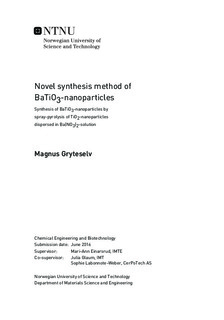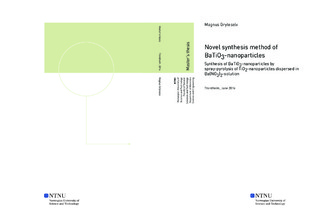| dc.description.abstract | Ferroelectric materials are widely used in different technological applications. Lead zirconate titanate (PZT) materials are currently the most used, due to their excellent piezoelectric properties and relatively high operating temperatures. However, due to high lead content and its environmental toxicity, lead-free alternatives are being explored. One such material is barium titanate (BaTiO3). Finding cheap, energy-efficient, and scalable synthesis methods for such materials is necessary to start phasing out PZT in favor of more environmentally friendly alternatives.
The particle size of ceramic powders is an important property as many materials exhibit different physical behavior when the particle size is in the nanometer range. Increased material strength, unique optical properties, and increased reactivity are some examples. Several applications of ceramic powders rely on this phenomenon; e.g. increased sintering activity where fine powder is needed to promote densification.
This work explores the possibility of synthesizing BaTiO3-nanoparticles through spray pyrolysis of a suspension with TiO2-nanoparticles dispersed in a barium nitrate solution. BaTiO3-nanoparticles with particle size between 50-100 nm were achieved. The importance of suspension stability with regard to phase purity and yield of produced powder was investigated. The results of the powder characterization indicate that complexing the barium-ions with ethylenediaminetetraacetic acid (EDTA) and citric acid (CA) may be necessary to achieve satisfactory stability and stoichiometric control of the suspension. Pellets were produced and the sintering behavior and piezoelectric properties of these pellets were investigated. The piezoelectric properties of the samples are comparable to reported values for BaTiO3 in regards to polarization values, but significantly lower than reported in regards to measured displacement values. The results indicate some contamination or secondary phase formation in the samples. The contamination is believed to originate from either the precursor powders, the spray-pyrolysis equipment or process, or a combination of both.
Further work is required to determine the usefulness of the method. The suspension stability must be improved to ensure stoichiometric control during the process. The source of the contamination or secondary phase formation must also be identified and eliminated. | |

